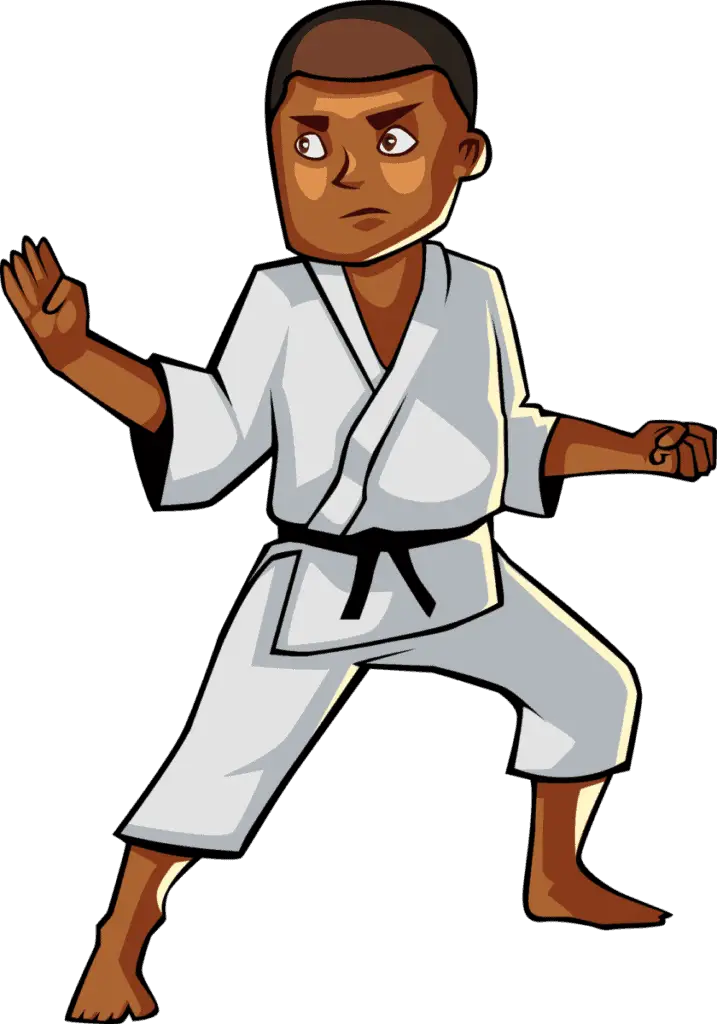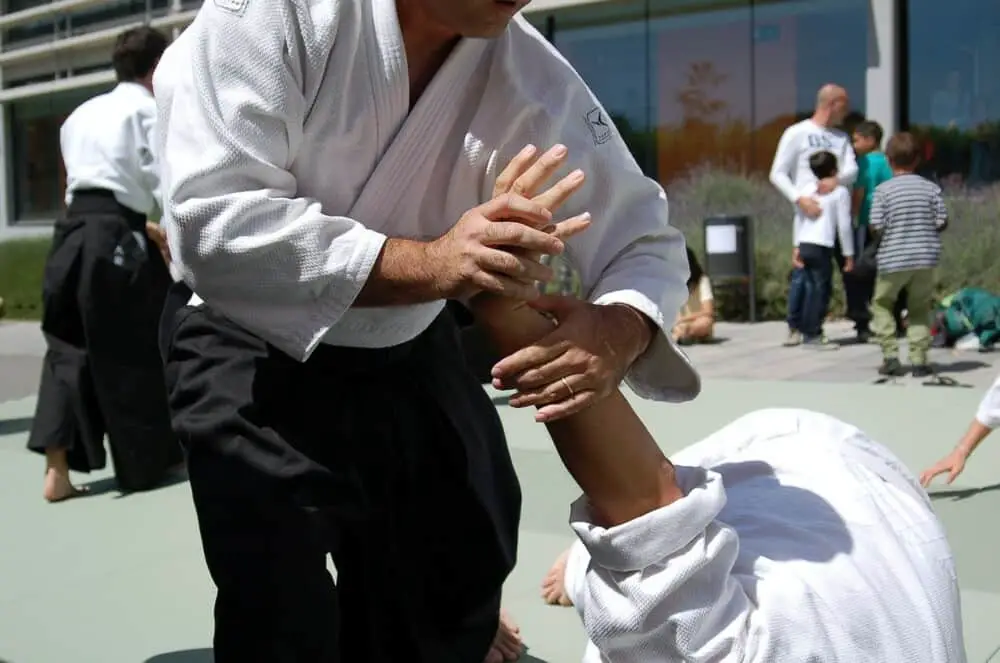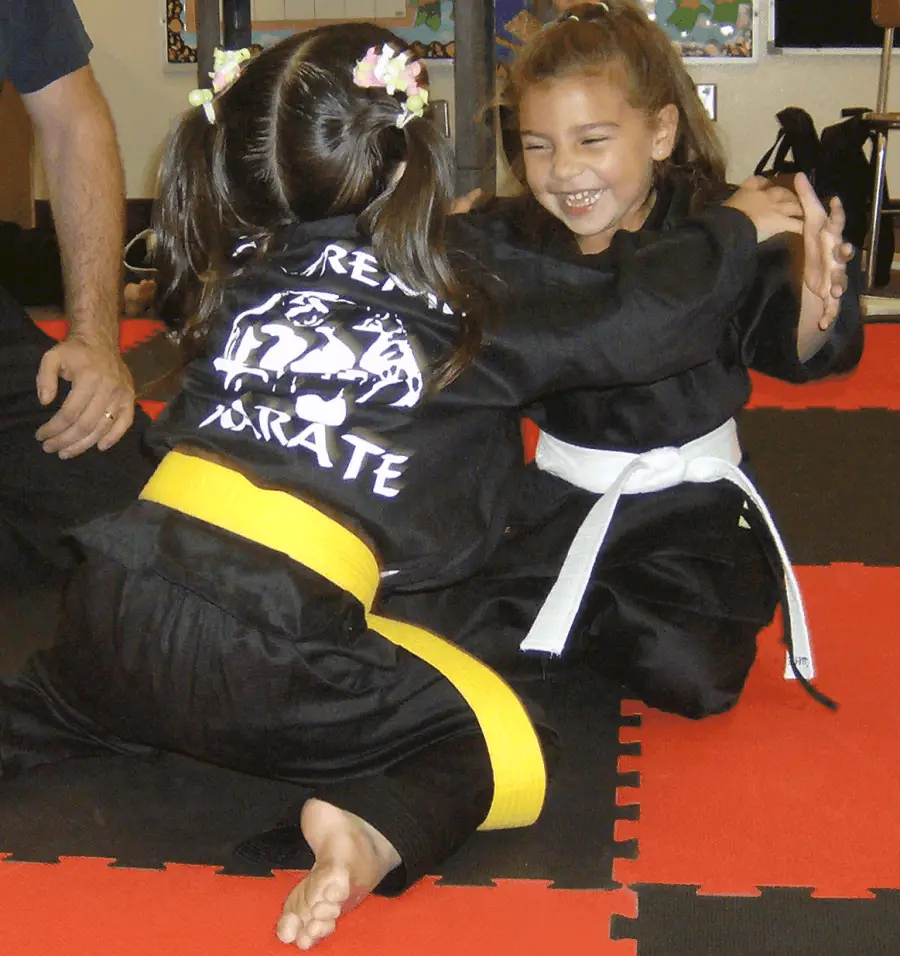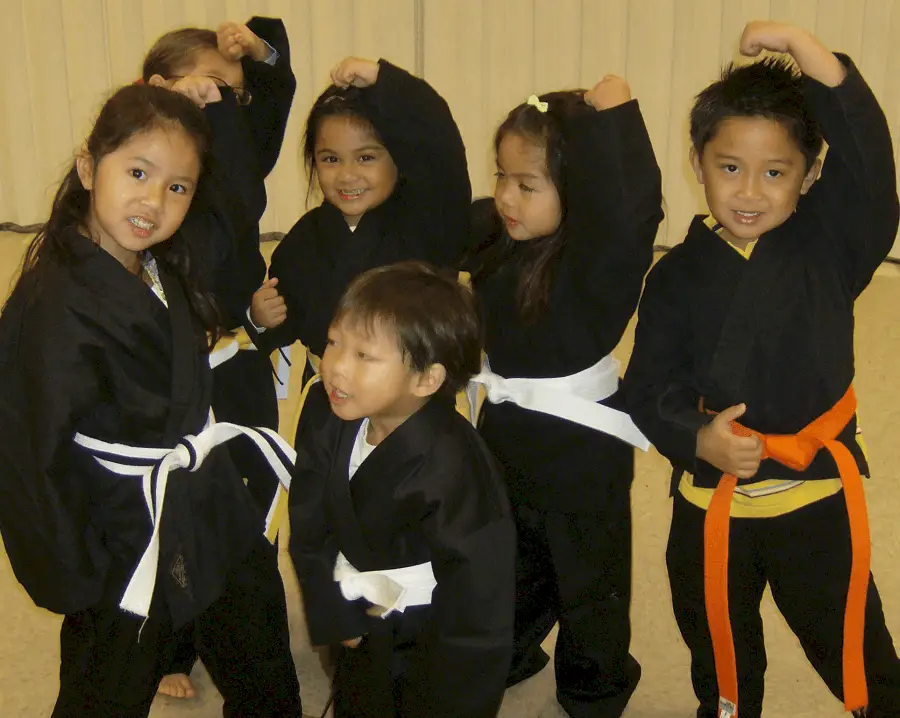
Discovering ways for children to channel their energy productively and grow in character are goals that many of us parents work towards. Signing your kids up for martial arts can accomplish these goals by reinforcing disciplined habits and self-control. With an emphasis on balance, problem-solving, and respect for oneself and others, martial arts encourage personal growth.
There are 5 martial arts that are great for instilling, developing and practicing discipline in children:
- HapKiDo – through learning complex moves
- Judo and Brazilian Jiu Jitsu- through restraining opponents
- Karate – through reaching higher ranks
- Taekwando – through belt system
- Muay Thai – through fighting against tough odds
Each martial art brings about its own benefits that may suit your child. Knowing about several different martial arts can help you choose the right martial arts discipline for your child. This is why we have compiled 5 of the best martial arts that can be used to reinforce discipline.
Contents
- HapKiDo for Kids: Looking Within for Discipline
- Judo And Brazilian Jiu-Jitsu for Kids: Using Problem Solving for Discipline
- Karate for Kids: Discipline Through Goal Setting
- Taekwondo for Kids: Persistence for Discipline
- Muay Thai for Kids: Mental Strength Drives Discipline
- The Best Martial Art for Disciplining Your Child
HapKiDo for Kids: Looking Within for Discipline

HapKiDo is a Korean martial art that emphasizes channeling inner energy as a form of defense that protects both yourself and your opponent. Unlike many other forms of martial arts, HapKiDo is a non-aggressive and non-competitive practice that requires strategizing and control to avert an opponent’s attacks.
This Korean martial art like its Japanese predecessor Aikido and Aikijitsu, promotes respecting one’s opponent and minimizes aggressive contact as much as possible with the redirection of energy and body movements (Source: Aikikai Foundation). HapKiDo is designed to bring together exercise and one’s inner energy, focusing more on the growth and “overcoming of oneself” than beating an opponent.
Why is HapKiDo Good for Kids?
We believe this is a great introduction to martial arts for children, especially younger kids, who may not be prepared for or interested in combative activities. It can be a good starting point to build up to other types of martial arts, as it emphasizes body control and self-improvement.
The reason for this is mainly because of its complete integration of the style of TaeKwonDo and its emphasis on self defense instead of sport.
This is then built upon as children grow and become more responsible to incorporate leverage, takedowns, and joint manipulations. These safe and age appropriate beginnings can grow into a full fledged martial art with all the benefits of long term goal setting.
If you are interested in the benefits of HapKiDo integrated in with the other styles on this list, check out my Online Martial Arts Classes for kids. The styles of HapKido, Judo, Karate, and Kali are all integrated into a heaping helping of fun, right from your own home. You control the environment and I deliver the fun.
These are some of the primary benefits of practicing HapKiDo for kids:
- Emphasizes conflict resolution: Because this art form is non-combative, one of the core principles is to approach fighting as a last resort. This is a helpful life lesson for children as they grow and are faced with conflict among their peers. This martial art will teach them how to resolve conflict in more constructive ways.
- Self-reflection and mental focus: Mental calm is a primary pillar of the practice, which not only drives performance in the sport but teaches kids how to regulate emotion in daily life (Source: Britannica). Moreover, participants focus on breathing and meditation, as well as movements.
- Promotes positive outlook: Creating positive energy and having a positive outlook on life is key to help achieve mental calm. Looking at the positives in situations help you to beat your opponent, and this carries over into everyday thinking. This is one of the few practices that takes body and mind into full account.
- Release of energy and exercise: Though this martial art uses non-aggressive tactics, movement and coordination are not ignored. This is a great opportunity for children to exercise and use their energy in controlled ways.
- Basics of TaeKwonDo included: Through the sport kicking and fitness style of TaeKwonDo distance control, body control, as well as physical fitness and flexibility are gained in the early stages. This prepares the child for life long martial arts practice, not to mention healthy success in life.
If you would like to see the best kicking bag specifically designed for the TaeKwonDo or HapKiDo student take a look here on Amazon.
How Does HapKiDo Promote Discipline in Kids?
The ability to focus on coordinating movements that mitigate conflict requires great discipline. For many, an initial reaction to an attacker would be to respond with aggression or violence. Tapping into a defensive position through breathing, meditation, and a positive outlook goes against our instincts and requires great discipline and practice to master.
Compared to other martial art forms, HapKiDo skills can take a while to master, especially the mental components. For this reason, the beginnings are based in TaeKwonDo. Once the child grows and matures into adulthood, the defensive ideals of force redirection and allowing an opponent to defeat themselves begins to develop.
However, with patience and consistent practice, disciplined habits can form and carry over into daily life. If your kid gets easily frustrated or would find the mental component boring (especially older kids), this may not be the right practice for them.
It is important that you look closely at the qualifications of instructors that are teaching HapKiDo courses. Because this martial art combines mental and environmental elements more than others, it is important that the instructor is creating an environment that promotes these values. The mental components of HapKiDo drive the entire practice.
Judo And Brazilian Jiu-Jitsu for Kids: Using Problem Solving for Discipline

Judo and Brazilian Jiu-Jitsu (BJJ) are wrestling-based martial arts with an objective of throwing, grappling or wrestling, and pinning down an opponent. The goal of the practice is to prevent your opponent from escaping your holds on the ground. The sport is strategic in finding the most effective way to get your opponent to submit based on their movements and actions.
Why are Judo and Brazilian Jiu-Jitsu Good for Kids?
Strategic and non-violent, the terms “Judo” means the “gentle way” and “jujitsu” translates to “gentle art” from Japanese. Most activity occurs from a standing or ground wrestling position and uses holding techniques as opposed to hitting or kicking for domination (Source: World Judo Day and Essential BJJ). Judo and BJJ may be less aggressive than other combative practices, but it still allows for a great deal of physical exertion and problem-solving skills.
Brazilian Jiu-jitsu and Judo are beneficial martial arts practice for the following reasons:
- Body Control: The sports will teach kids how to use their bodies to beat an opponent through executing explosive movements and pressure in holds. Reaction time and bodily awareness are necessary to successfully respond to an opponent’s attack.
- Reasoning skills: Kids may find themselves trying to hold an opponent in a submissive position or trying to problem-solve their way out of a tight hold. Strategizing their movements to maintain a better position is the basis for the sport, and this helps with mental growth.
- Stress relief: Stress relief and the grappling arts go hand in hand. When practicing BJJ or Judo, kids get to expel endorphins through exercise, shift their mental focus completely to the practice, and release tension through fighting. This helps to reduce stress levels from school and life (Source: Renzo Gracie).
- Fitness and strength: Being in ground positions helps kids to develop full-body strength and fitness. This is because being able to resist an opponent while in a tight hold requires muscular endurance. This same endurance is needed to attack opponents.
- Flexibility: Being on the mat trying to break free from an opponent will put kids’ bodies in positions they may not be used to. This will test and improve their flexibility.
How Do Judo and Brazilian Jiu-Jitsu Promote Discipline in Kids?
These sports are non-violent martial art that require you to use the least amount of force necessary to beat an opponent. Participants may be tempted to overpower their opponent in ways that could injure them, which would signify a loss of control. Only applying necessary force requires restraint and discipline in the proper execution of the moves (Source: Evolve-MMA).
To win matches, you need to consistently work on your technique and make sure that your movements cannot be combatted by the opponent. This requires in-depth knowledge of moves and grappling with sparring partners, siblings, friends, or even parents (Dads, get ready to rumble!). This consistency in practice instills a strong work ethic and discipline that is required to excel in both the sport and everyday life.
We recommend Judo or Brazilian Jiu-Jitsu for kids who like doing strategic activities and prefer to do so in an active manner. They’ll learn the skills required to beat their opponents through self-restraint and other discipline-driven methods.
Karate for Kids: Discipline Through Goal Setting

Karate is one of the most popular martial arts practiced by kids and adults around the world. More combative in nature than aikido and BJJ, the sport teaches kids to both strike their opponents and block advances with their arms and legs. It is recommended that children who practice karate are at least 3 years old (Source: Made4Fighters).
This being said, Karate also incorporates the grappling of Judo and Jujitsu along with the traditional weapons techniques of the ancient samurai and others. This tends to be the most complete and well rounded style as long as the instructor is faithfully instructing in the three categories of grappling, empty hand striking, and weapons play.
Why is Karate Good for Kids?
Because there are many karate classes offered for kids, you are likely to find very qualified instructors. Quality instructors will teach proper technique and offer environments for your children to grow and develop, both physically and mentally. Finding a good fit in an in person or online dojo is important for the child to excel and want to continue the practice.
Karate is a great kid’s martial arts practice for the following reasons:
- Emphasizes respect: Typical in many martial arts practices, bowing to instructors and peers emphasizes the importance of respecting others. Karate is meant to be a supportive environment where you encourage your peers.
- Focus and concentration: Learning the movements and listening to instructions are important for mastery. Abiding by rules and following set routines is a large part of this. These components, in particular, are helpful for kids with learning difficulties or attention disorders (Source: Understood).
- Self-improvement: The child’s contributions to their training will allow them to advance. This means practicing in class as well as at home to develop skills. Looking at your strengths and weaknesses and spending time to consistently improve is a positive habit that will be used beyond the sport.
If you are interested in keeping your kids interested in the practice and not only the benefits of the discipline, read this article to find out what is the most fun marital art for kids. If the child does not find the style fun to practice, the benefits will never be attained. The child will simply want to stop training. Then nothing is gained.
How Does Karate Promote Discipline in Kids?
With the belt-based system of achievement, kids are required to practice and master skills to reach higher levels. Advancing in the sport requires discipline in the forms of dedicating time to attending classes and putting effort into learning and performing karate skills. This discipline is closely tied to goal setting, which is a key element in focusing on disciplined behaviors (Source: ActiveKIDS).
The patience required for progressing through the levels in the karate hierarchy is essential for developing and practicing discipline. Because these progressions often span over months and years of practice, reaching a new level in karate limits instant gratification and requires kids to follow through on their commitment to the sport.
Taekwondo for Kids: Persistence for Discipline

Originating in Korea, Taekwondo is a popular martial art that places a large emphasis on kicking and punching. “Taekwondo” translates to “foot hand art” (Source: Master Chong’s World Class Taekwondo). The sport requires balance and power for striking, as well as a great reaction time to stop an opponent’s advance.
Taekwondo is recommended for kids who are already fairly self-motivated, as it will require a lot of training to move through the belt system and master challenging skills. It’s best for kids to start Taekwondo at a young age, as it will take years to reach higher levels. However, some younger kids may not be as committed to the sport as older kids may be.
You can read more about the belt ranking and times to black belt for this highly popular kids martial arts style here in my article all about TaeKwonDo.
Why is Taekwondo Good for Kids?
Taekwondo promotes many of the same values as other martial arts forms but is more demanding in terms of flexibility and agility than some of the others mentioned on our list. This will help kids to improve their physical fitness, as well as many other areas for personal growth.
To see an amazing kicking bag specially designed for the kicks of TKD, check out this link to it on Amazon.
Some of the primary benefits of Taekwondo for kids include:
- Values consistency and persistence: In Taekwondo, skills are very challenging to master, so a child will need to focus on being consistent in their movements through repeated practice. It can be challenging to make progress initially, but successful Taekwondo fighters develop the discipline to stick with it.
- Builds confidence: Mastering Taekwondo skills after putting in hours of hard work results in a greater sense of confidence in kids. Competing against yourself and focusing on self-improvement further builds self-esteem. This confidence spills over into other areas of life.
- Teamwork: In Taekwondo, kids must collaborate with classmates to challenge each other and work on new skills, which builds a sense of comradery and improves socialization in group settings (Source: Taekwondo Nation). Achieving new belts with your peers adds a team element to the sport.
- Balance and control: Beyond physical exertion, being able to move your body strategically and with purpose is challenged in this sport. Also, improved balance is important for injury prevention and overall greater athletic output (Source: American Heart Association).
How Does Taekwondo Promote Discipline in Kids?
Similar to karate, Taekwondo uses a belt system that drives discipline through skill mastery and goal setting. The movements taught in this sport are also challenging, requiring a healthy measure of discipline and patience.
Developing a laser focus on obtaining higher levels of achievement comes in handy when it comes to school and other extracurricular activities. Also, the self-esteem kids build from their disciplined efforts can help them to tackle other projects and goals with greater confidence.
The best martial art for your child is one that is taught by highly trained professionals, promotes safe practice, and instills traditional martial arts values to build confidence and discipline through effort and skill progression (Source: Matt Pasquinilli). Make sure that Taekwondo instructors are qualified and encourage skill development for instilling discipline.
Muay Thai for Kids: Mental Strength Drives Discipline
Thailand’s national sport, also known as “Thai boxing” or “Muay Thai” is a more advanced martial art that focuses on combative techniques. This sport is recommended for older children or kids who already know other forms of martial arts. It is similar to kickboxing, where you use multiple body surfaces to strike the opponent (Source: World Muaythai Council).
Participants compete in a ring with gloves similar to traditional boxing; the overall objective is to knock the opponent out. For kids, sparring and learning techniques are at the heart of Muay Thai.
Why is Muay Thai Good for Kids?
Muay Thai is recommended for kids that are looking for a more active form of martial arts exercise and are comfortable with its combative nature. This also takes parents that do not mind the more aggressive nature and boxing combative nature of this style.
If your kid is more aggressive, Muay Thai gives them an opportunity to channel this energy in productive ways that also benefit their health. However, non-aggressive kids may find Muay Thai to be uncomfortable; it’s really important to take this into account.
These are the benefits of kids practicing Muay Thai:
- Self-defense: Of the martial arts practices on our list, Muay Thai is one of the most practical for self-defense in real-life situations. This is because Muay Thai trainers train pupils extensively in both offensive and defensive techniques.
- Awareness and mindfulness: Muay Thai is rooted in Buddhism, in which a clear mind is a core value. Approaching training with clarity and deliberate decision making heightens awareness, fostering better physical control, and a healthy mental state (Source: Toronto Striking Academy).
- Physical fitness: A session of sparring with a partner is physically demanding and will promote an active and healthy lifestyle for your child. Continuous training will improve their fitness levels to compete at a higher level for longer.
How Does Muay Thai Promote Discipline in Kids?
Muay Thai is a physically and mentally demanding sport that requires you to maintain high levels of focus while competing at a high fitness level. Training for the sport will require time competing against sparring partners as well as working on your cardiovascular endurance to last longer in competitions. In the moments you want to quit, this is where discipline comes in.
In the beginning of Muay Thai training, or in integrated systems that include some of Muay Thai’s techniques, drills and body conditioning are front and center. To be sure, kids do not have to move on to competition in these environments. Yet, to be ready for these types of competition takes fairly grueling training. Make sure you and your child are ready for this if this is the path you want to take.
Due to Muay Thai’s combative nature, kids have no choice but to learn how to persist despite adversity. Equally important is a sense of discipline in the overall technique.
The Best Martial Art for Disciplining Your Child
The best way to teach your kids discipline through martial arts is to choose a discipline that your child will enjoy and commit to; otherwise, your child will not reap the benefits of participation. If you child simply quits, nothing is gained. To learn more about martials arts and discipline, read here.
Establishing a routine, consistently practicing, and following through on commitments will help to promote discipline in your child. While each martial art has the ability to discipline your child, not every style of martial arts will be a good fit for every child.
